Americas: conquest and settlement
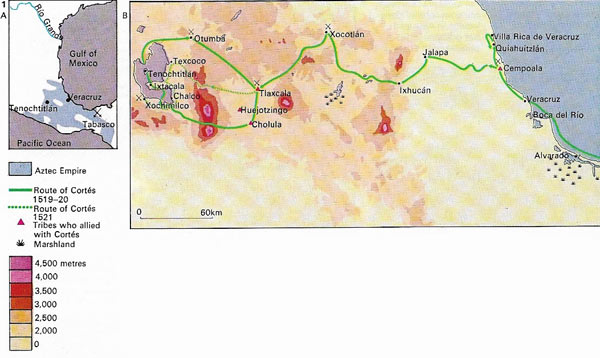
Figure 1. Cortes landed at Veracruz (A) on 22 April 1519. By forming alliances with the peoples of Cempoala, Jalapa and Tlaxcala, he maintained his supply line with the coast (B). After skirmishes, he persuaded the powerful independent "state" of Tlaxcala to join him, thus obtaining the much-needed base from which to launch his attack on the Aztec capital of Tenochtitlan. After the retreat of the "Sorrowful Night" on 30 June 1520, Cortes fled to Tlaxcala. With the help of local workmen he built a fleet of brigantines to harass the defenders of Tenochtitlan from the lake. These were carried in pieces and assembled on the lakeshore, while the army, composed largely of Tlaxcalans, attacked the towns that seemed sympathetic to the beleaguered Aztecs.
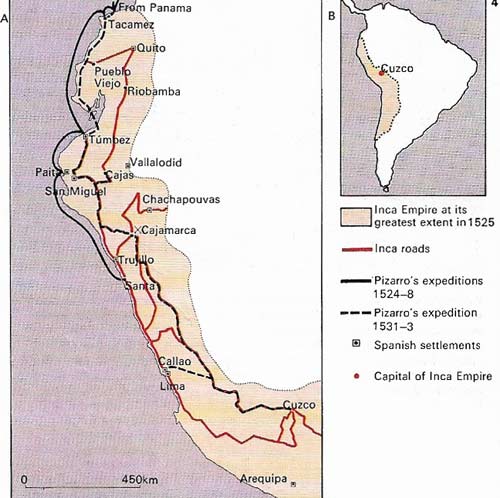
Figure 2. A superb network of roads helped Pizarro to conquer Peru. Reaching Tumbez in 1531, he then marched inland to Cajamarca to find the Inca ruler Atahualpa. Following a surprise attack, the city fell, and Atahualpa himself was later executed. Pizarro founded a new capital at Lima, thus shifting the center of Inca society from Cuzco to the coast.
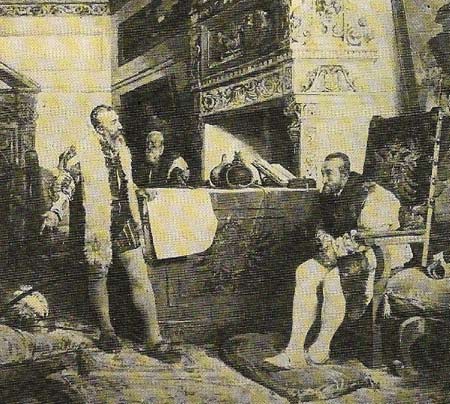
Figure 3. Charles V gave his support in 1528 to Pizarro's third expedition to Peru. Pizarro had accompanied Balboa on his March across the isthmus of Panama in 1513 and later formed a partnership with Diego de Almagro and Fernando de Luque to settle Peru and seek out the riches of the Incas. The first expeditions (1524–1528) were unsuccessful. In 1531, Pizarro and his brothers left Panama for Peru, joined later by Almagro. Pizarro lacked the diplomatic skills of Cortes and was unable to curtail the ambitions of his followers. Shortly after the subjugation of the Incas, Almagro broke away and during the ensuing civil was Pizarro was murdered.
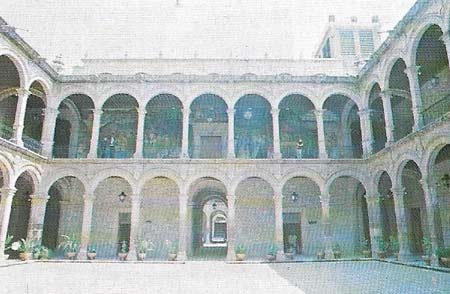
Figure 4. The Spanish crown rapidly replaced the conquistadores with its own officials, who set up a complicated government machine providing check and balances to prevent any single individual from growing too powerful. There was also the audiencia, a court of appeal to which every citizen had recourse and which was responsible directly to Spain. This former governor's palace is in now Morelia, central Mexico.
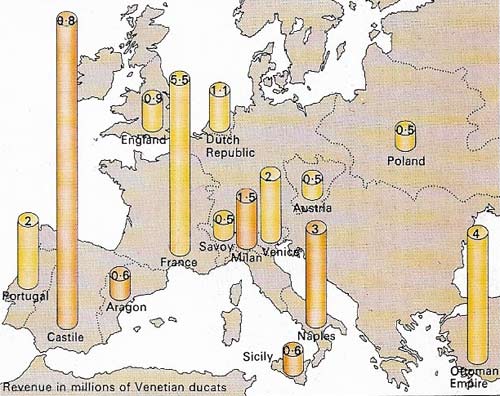
Figure 5. Silver bullion from the Indies provided Castile especially with great wealth during the 16th century, but the influx slowed as the mines were worked out in the 17th. The massive inflation of 17th-century Europe may have derived from these imports of American silver.
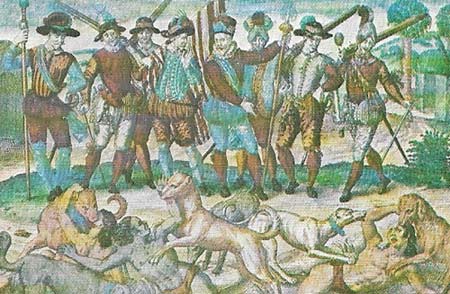
Figure 6. Spanish cruelty towards the Indians was notorious. Brief Relation of the Destructions of the Indies by Bartolome de las Casas, which became a bestseller during the 16th century, helped to foster and disseminate this "black legend". This popularity, however, was due more to fear and hatred of Spain than to love of the Indians. This illustration by De Bry appeared in The Netherlands as anti-Spanish propaganda.
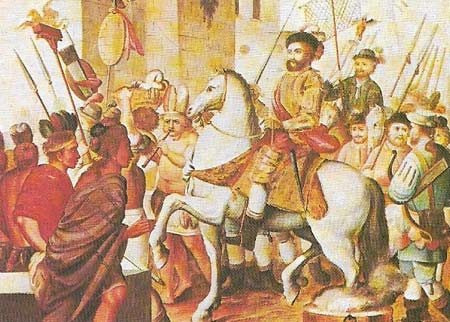
Figure 7. The conquest of America by Europeans in the 16th century meant that the indigenous cultures were almost wiped out, because of the Spaniards' desire to convert the Amerindians to Christianity, the traditional features of the native way of life were absorbed into dominant culture, although this process was uneven. The tribes that survived were the most primitive and they never developed, but the civilization of the Aztecs and Incas wholly disappeared.
By the early sixteenth century the Spaniards had established colonies in the Antilles and the Isthmus of Panama. The mineral resources of these islands, however, proved to be slender and, despite the name Golden Castile, the area had little to offer. Trading expeditions along the coast of Yucatan revealed a likelihood of greater wealth in the interior. In 1519, after two preliminary expeditions, the governor of Cuba, Diego de Velazquez (c. 1460–c. 1524), sent a fleet under Cortes to settle the region (Figure 1A).
The major conquests
Hernan Cortes (1485–1547) and his expedition of 550 men landed on the coast of Mexico and founded the settlement of Veracruz. Cortes then threw over Velazquez's authority and placed himself directly under the crown. By a series of adroit diplomatic moves and superior military technology, Cortes took formal possession of the Aztec capital of Tenochtitlan. He was welcomed by its ruler, Montezuma, whom he promptly imprisoned. According to Cortes, Montezuma made a willing donation of his empire to Charles V in the mistaken belief that Cortes was the emissary of the god Quetzalcoatl. This widely circulated story is almost certainly a fable.
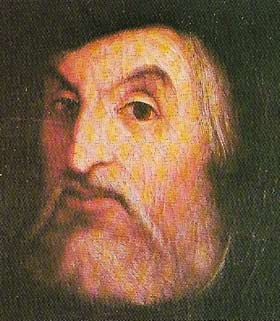 |
| Hernan Cortes was born in the province of Estremadura in Spain. He sailed for Hispaniola in 1504 and as Velazquez's lieutenant, he took part in the conquest of Cuba. His career subsequent to the conquest of Mexico was, like that of so many conquistadores, spent largely in an effort to secure from the crown due recognition of his achievements. He died in Spain in 1547. |
The conquest of Peru in 1532 by the adventurer Francisco Pizarro (c. 1471–1541) (Figure 3) was the result of the search for gold. When the Spaniards arrived on the Peruvian coast at Tumbez, the Inca Empire was divided by a civil war. Atahualpa emerged victorious shortly before Pizarro caught up with him at the fortress of Cajamarca (Figure 2). Here the Spaniards succeeded in killing most of Atahualpa's retinue and capturing the Inca himself. Atahualpa offered to fill his cell with gold in exchange for his freedom.
Pizarro accepted, but although Atahualpa kept his part of the bargain he was not released. The value of his ransom has been estimated at about 20 million dollars. It included the treasures of the Temple of the Sun and was all melted down for bullion. Pizarro lacked Cortes's powers of leadership and after the subjugation of the Inca Empire, the conquerors began to fight among themselves. The civil war lasted until the death of Pizarro in 1541 and the execution of his brother Gonzalo in 1548. With the conquest of Peru, the attention of the European explorers turned elsewhere. Expeditions were sent to Texas and Florida and some settlements were established. The colonization of New Mexico was slightly more determined but the area soon became little more than a military outpost.
Administration
The Spanish crown, fearful lest the more successful of the conquistadores (conquerors) should set up independent feudatories, rapidly took control of the government of the new colonies. The administration was complex. At the top was the viceroy, responsible only to the crown (Figure 4). The distance between Spain and the Indies inevitably placed great power in his hands.
To maintain the balance of power within the colony, a separate court of appeal, the audiencia, was established. This had the right of direct representation before the crown and could suspend crown officials from their duties; it also served to represent the Indians before their overlords and to administer justice. The crown also imposed the system of residencia, whereby a crown official was examined at the end of his term of office and any misconduct punished. These cumbersome institutions were often ill-equipped to deal with the American situation.
The Indians were "granted" to settlers under the encomienda system. Theoretically this provided the colony with a salaried labour force; each settler was given a number of Indians (but not their lands) from whom he took tribute or labour. The position of the Indian was therefore rather like that of the European serf and the power that this appeared to give to the colonists forced the crown to make several efforts to abolish the system. By the Laws of Burgos of 1512–1513 and subsequent royal decrees, the number of Indians held in encomienda was limited and their duties were to some extent lightened.
The wealth of the Americas
The great wealth of America lay in its silver deposits. The mines of Potosi in Peru and of Zacatecas, Guanajuato and the other Potosi in Mexico were all discovered during the 1540s and their output soon came to dominate the European silver market. The colonists benefited little, however, and were forced to subsist on agriculture and trade in lesser commodities, such as silks, with the Philippines. Precious metals were shipped via Seville which enjoyed a monopoly of America's trade and where a clearing house, the Casa de la Contratación, had been set up as early as 1503. The Americas had always been a Castilian venture and the Castilian crown benefited directly (Figure 5).
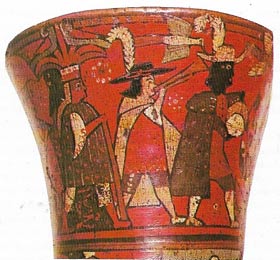 |
| This 17th-century Inca wooden beaker shows Peruvian Indians and a European together. At first, the Spaniards tried to preserve the Indian social structure, using local chieftains as justices and tax collectors. However, over the course of the 17th century, the native nobility intermarried and the Spaniards took Indian women as concubines, producing a mixed group known as mestizos. The Indian culture declined and was supplanted by that of white, or near-white society. |
The impact of Spanish colonization upon the New World was considerable. The introduction of European crops and livestock destroyed the domestic life of the Indians and altered the ecological balance of central Mexico. The disruption of old tribal divisions and of the hierarchy of Aztec society produced an alienated, enfeebled community which rapidly succumbed to European diseases so that the population declined rapidly during the sixteenth century. Latin America thereafter was a mixed culture dominated by that of the Spanish settlers.
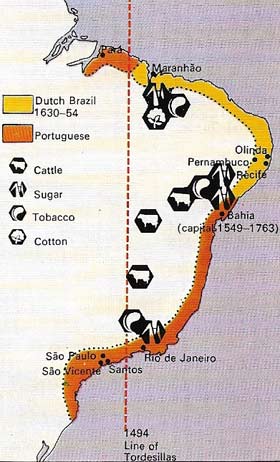 |
| By the Treaty of Tordesilias of 1494 the Spaniards and Portuguese - at the instigation of Pope Alexander VI – agreed to a demarcation line between their territorial claims. When Brazil was discovered in 1500 by Cabral, Portugal naturally claimed it but mid not seriously colonise it until 1530. Spain and Portugal were United between 1580 and 1640, so that Brazil was open to attack by Spain's enemies. In 1630, the Dutch seized a rich area in the north, which they kept until 1654 when they were driven out by wealthy landowners. Throughout the 17th century, the Brazilian economy developed rapidly, based on sugar and tobacco together with cotton and cattle. |
